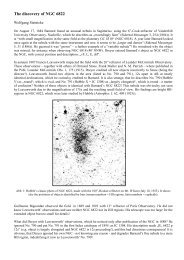John Louis Emil Dreyer – A Short Biography
John Louis Emil Dreyer – A Short Biography
John Louis Emil Dreyer – A Short Biography
You also want an ePaper? Increase the reach of your titles
YUMPU automatically turns print PDFs into web optimized ePapers that Google loves.
Birr Castle<br />
In August 1874 <strong>Dreyer</strong>, then aged 22, left Copenhagen for Irish Parsonstown (now Birr). He was employed as<br />
Astronomer at the Earl of Rosse’s Observatory to assist Lawrence Parsons, the Fourth Earl of Rosse. He followed<br />
Ralph Copeland, who changed to Dunsink. The 15-years-older English astronomer was a life-long friend. In 1875<br />
<strong>Dreyer</strong> became a Fellow of the Royal Astronomical Society (RAS).<br />
At Birr Castle he had access to the 36" and 72" reflectors (Fig. 2) and his main task was observing and<br />
cataloguing nebulae. Here <strong>Dreyer</strong> wrote his first papers on the subject: reviews of the publications of Schultz,<br />
Schönfeld and Vogel, which appeared in the Vierteljahrsschrift der Astronomischen Gesellschaft (<strong>Dreyer</strong> 1875,<br />
1876a, 1876b). In 1877 he published his first catalogue of non-stellar objects, the ‘Supplement to <strong>John</strong> Herschel’s<br />
General Catalogue’ (GCS; <strong>Dreyer</strong> 1878). He was also responsible for the compilation of all Birr Castle<br />
observations of nebulae, which appeared in 1880 (Parsons 1880). That work contains some of his sketches.<br />
Fig. 2: Lord Rosse’s 72" reflector at Birr Castle.<br />
In Parsonstown <strong>Dreyer</strong> met the woman who was later to become his wife, Katherine ‘Kate’ Hannah Tuthill,<br />
daughter of <strong>John</strong> Tuthill from Kilmore (County Limerick). The marriage took place on 11 November 1875 at the<br />
local church. On 24 December 1876 their son <strong>John</strong> ‘Jack’ Tuthill <strong>Dreyer</strong> was born, followed by Frederic Charles (8<br />
January 1878). <strong>Dreyer</strong> stayed at Birr Castle for four years. No doubt he was the driving force and his departure<br />
initiated the decline of the wellrespected observatory.<br />
Dunsink Observatory<br />
In August 1878, aged scarcely 26, <strong>Dreyer</strong> moved to Dunsink, the site of the Trinity College Observatory of<br />
Dublin University. 4 He became the assistant of Robert Stawell Ball, following Charles Burton (both former Birr<br />
Castle observers). Ralph Copeland <strong>–</strong> who had been an assistant at Dunsink during 1874<strong>–</strong>76, before changing to<br />
Lord Lindsay’s Dun Echt Observatory in Scotland <strong>–</strong> might have recommended him for the job. Ball entrusted the<br />
young astronomer with observations at the meridian-circle by Pistor and Martins (well known from Copenhagen).<br />
<strong>Dreyer</strong> measured, for instance, the positions of 321 red stars (a catalogue appeared in 1882 in Dublin). His daughter<br />
Alice Beatrice <strong>Dreyer</strong> (later Shaw-Hamilton) was born in Dunsink on 28 October 1879.<br />
<strong>Dreyer</strong> and Copeland edited the Dublin magazine Copernicus bearing the subtitle ‘International Journal of<br />
Astronomy’. From January to July 1881 it was first titled ‘Urania’. Since a publication with the same name already<br />
4 Dunsink lies about 100 km east of Birr; see O’Hora (1961) and McKenna (1967): 283<strong>–</strong>285.











![SFB2011 Zeit [Kompatibilitätsmodus]](https://img.yumpu.com/4636501/1/190x135/sfb2011-zeit-kompatibilitatsmodus.jpg?quality=85)